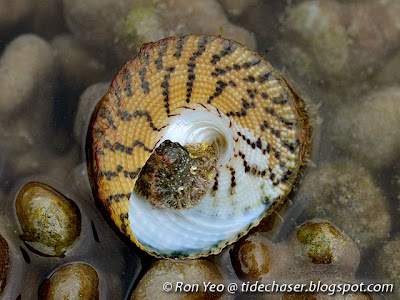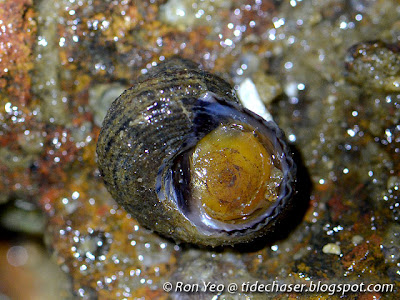The trochids are sometimes called top shells as the shells of many species resemble toy tops. They have a thin and round operculum (the trap door) which allows them to retreat deep into their shells when threatened. Most species feed on algae and detritus (tiny decaying matter), but some smaller species may filter plankton and other edible particles from the water column. The bigger species are collected for food, and as their shells have a nice iridescence when polished, some are collected for making decorative items or cut into buttons.
Here are some of the top shells that I have photographed and identified on our shores so far (thanks to Siong Kiat who gave tips on how to identify them!). You may want to take a look at my diagram on the parts of a snail's shell if you are not familiar with the names of the parts, so as to better understand the terms used below.

The Maculated Top Shell (Trochus maculatus) is the most commonly seen top shell on our rocky shores and among intertidal coral rubble. It is top-shaped and the shell is marked with vertical wavy streaks. It is usually covered with algae and sediment though, and hence it is often hard to identify it just by looking at the upper side. "Maculated" means "marked with spots or stains". It can grow to about 7cm high, but most of the ones I have seen are less than 5cm.

The underside of the Maculated Top Shell is rather distinctive though. It has many distinct, zigzag, lightning-like, black or dark brown streaks radiating out from the centre.

The Radiate Top Shell (Trochus radiatus) is also often encountered on our rocky shores or among coral rubbles, and looks very similar to the previous species. It is also top-shaped, and often covered with algae and sediment. The vertical bands running down the top side of the shell, however, are usually broader. The height is also usually shorter than the previous species, with the biggest I have seen about 4cm high.

The more reliable way to differentiate the Radiate Top Shell from the previous species is by looking at the underside - it has a greenish tinge, which is especially obvious in the centre. Many of the reddish streaks radiating from the centre are connected to each other, sometimes forming net-like patterns.
Both top shell species above can be confused with juvenile Giant Turban Snails, which are also top-shaped. The latter, however, has spiral rows of nodules on the shell.

The Beautiful Clanculus (Clanculus margaritarius), when looked closely, has spiral rows of tiny pearl-like nodules that are orange, whitish or dark brown in colour. Interestingly, the whitish nodules and the dark brown nodules usually occur side-by-side. It is usually found on the undersides of rocks during low tide. The species name, "Margaritarius" means "pearl".

They sometimes have a thin film of algae growing over them, but the ones I have seen are usually still obvious enough to be identified.

The underside of mature snails will have an obvious tooth on the outer lip, but unfortunately I only have the photograph of the underside of a juvenile, which still has not yet exhibited this feature.

The Toothed Top Shell (Monodonta labio) is also commonly seen on our rocky shores, usually occuring on higher shores compared to the other species above. It can also be found on mangrove trees sometimes. The shell is marked with spiral rows of nodules of lighter and darker colours, with the ones on the body whorl much larger than the ones on the spire. This shell is somewhat turban-shaped, and hence can be confused with the turban shells.

It can, however be differentiated by the thin corneous operculum, and a big tooth at the bottom of the columella (seen at the top of the aperture in the photo above).

The Button Top Shell (Umbonium vestiarium) is very different from all the previous species - it occurs on sandy shores, comes in a wide variety of colours (pink, red, brown, grey, bronze, gold, etc) and patterns (spotted, streaked, blotched etc.), and is a filter feeder! It apparently uses its longer right tentacle to collect plankton and other tiny food particles from the water, and the shorter left tentacles is believed to have some sensory functions.

Button shells generally occur in huge populations, and thousands are usually seen together, half buried under the sand. Due to their pretty colours and patterns, they are, unfortunately, often collected for shellcraft.
Snail families that resemble top shells:

Top shells are easily confused with the closely related turban snails, especially for turban snails that are top-shaped. The Giant Turban Snail (Tectus niloticus) is a top-shaped turban snail that was previously classified as a top shell due to its shape and its corneous operculum, but genetic studies revealed it to be a turban snail instead. Find out more about the turban snails at my page on Turban Snails (Phylum Mollusca: Family Turbinidae) of Singapore.

Chilodontid snails from the family Chilodontidae can also be confused with the top shells, and in fact they were previously classified as top shells. The chilodontid snails are usually more turban-shaped, such as the Four-keeled Euchelus (Euchelus quadricarinatus) above. Find out more about the chilodontid snails at my page on Chilodontid Snails (Phylum Mollusca: Family Chilodontidae) of Singapore.
References
Here are some of the top shells that I have photographed and identified on our shores so far (thanks to Siong Kiat who gave tips on how to identify them!). You may want to take a look at my diagram on the parts of a snail's shell if you are not familiar with the names of the parts, so as to better understand the terms used below.

The Maculated Top Shell (Trochus maculatus) is the most commonly seen top shell on our rocky shores and among intertidal coral rubble. It is top-shaped and the shell is marked with vertical wavy streaks. It is usually covered with algae and sediment though, and hence it is often hard to identify it just by looking at the upper side. "Maculated" means "marked with spots or stains". It can grow to about 7cm high, but most of the ones I have seen are less than 5cm.

The underside of the Maculated Top Shell is rather distinctive though. It has many distinct, zigzag, lightning-like, black or dark brown streaks radiating out from the centre.

The Radiate Top Shell (Trochus radiatus) is also often encountered on our rocky shores or among coral rubbles, and looks very similar to the previous species. It is also top-shaped, and often covered with algae and sediment. The vertical bands running down the top side of the shell, however, are usually broader. The height is also usually shorter than the previous species, with the biggest I have seen about 4cm high.

The more reliable way to differentiate the Radiate Top Shell from the previous species is by looking at the underside - it has a greenish tinge, which is especially obvious in the centre. Many of the reddish streaks radiating from the centre are connected to each other, sometimes forming net-like patterns.
Both top shell species above can be confused with juvenile Giant Turban Snails, which are also top-shaped. The latter, however, has spiral rows of nodules on the shell.

The Beautiful Clanculus (Clanculus margaritarius), when looked closely, has spiral rows of tiny pearl-like nodules that are orange, whitish or dark brown in colour. Interestingly, the whitish nodules and the dark brown nodules usually occur side-by-side. It is usually found on the undersides of rocks during low tide. The species name, "Margaritarius" means "pearl".

They sometimes have a thin film of algae growing over them, but the ones I have seen are usually still obvious enough to be identified.

The underside of mature snails will have an obvious tooth on the outer lip, but unfortunately I only have the photograph of the underside of a juvenile, which still has not yet exhibited this feature.

The Toothed Top Shell (Monodonta labio) is also commonly seen on our rocky shores, usually occuring on higher shores compared to the other species above. It can also be found on mangrove trees sometimes. The shell is marked with spiral rows of nodules of lighter and darker colours, with the ones on the body whorl much larger than the ones on the spire. This shell is somewhat turban-shaped, and hence can be confused with the turban shells.

It can, however be differentiated by the thin corneous operculum, and a big tooth at the bottom of the columella (seen at the top of the aperture in the photo above).

The Button Top Shell (Umbonium vestiarium) is very different from all the previous species - it occurs on sandy shores, comes in a wide variety of colours (pink, red, brown, grey, bronze, gold, etc) and patterns (spotted, streaked, blotched etc.), and is a filter feeder! It apparently uses its longer right tentacle to collect plankton and other tiny food particles from the water, and the shorter left tentacles is believed to have some sensory functions.

Button shells generally occur in huge populations, and thousands are usually seen together, half buried under the sand. Due to their pretty colours and patterns, they are, unfortunately, often collected for shellcraft.
Snail families that resemble top shells:

Top shells are easily confused with the closely related turban snails, especially for turban snails that are top-shaped. The Giant Turban Snail (Tectus niloticus) is a top-shaped turban snail that was previously classified as a top shell due to its shape and its corneous operculum, but genetic studies revealed it to be a turban snail instead. Find out more about the turban snails at my page on Turban Snails (Phylum Mollusca: Family Turbinidae) of Singapore.

Chilodontid snails from the family Chilodontidae can also be confused with the top shells, and in fact they were previously classified as top shells. The chilodontid snails are usually more turban-shaped, such as the Four-keeled Euchelus (Euchelus quadricarinatus) above. Find out more about the chilodontid snails at my page on Chilodontid Snails (Phylum Mollusca: Family Chilodontidae) of Singapore.
References
- Carpenter, K. E. & V. H. Niem (eds), 1998-2001. FAO species identification guide for fishery purposes. The living marine resources of the Western Central Pacific. Volumes 1 to 6. FAO, Rome. pp. 1-4218.
- Gladys Archerd Shell Collection at Washington State University Tri-Cities Natural History Museum. 2008. Retrieved September 26, 2012, from http://shells.tricity.wsu.edu/ArcherdShellCollection/ShellCollection.html.
- Oliver, A. P. H., 2012. Philip's guide to seashells of the world. Philip's, London. 320 pp.
- Tan, K. S. & L. M. Chou, 2000. A guide to common seashells of Singapore. Singapore Science Centre, Singapore. 168 pp.
- Tan, S. K. & H. P. M. Woo, 2010. A preliminary checklist of the molluscs of Singapore. Raffles Museum of Biodiversity Research, National University of Singapore, Singapore. 78 pp. Uploaded 02 June 2010.
- Tan, S. K. & R. K. H. Yeo, 2010. The intertidal molluscs of Pulau Semakau: preliminary results of “Project Semakau”. Nature in Singapore, 3: 287–296.
- World Register of Marine Species. 2012. Retrieved Oct 3, 2012, from http://www.marinespecies.org.

No comments:
Post a Comment